The TIE/ln space superiority starfighter, also known as the TIE/LN starfighter or TIE/ln starfighter and commonly called the TIE fighter or simply the TIE/ln, was the signature starfighter of the Galactic Empire and symbol of its space superiority. Its official production name was the Twin Ion Engine "line edition" space superiority starfighter. Instantly recognizable from the roar of its engines as well as its unique design, the TIE/ln exuded Imperial power and prestige across the galaxy, seeing use throughout the Empire's reign. They were nicknamed Evil-Eyes or Eye-balls by members of the New Republic.
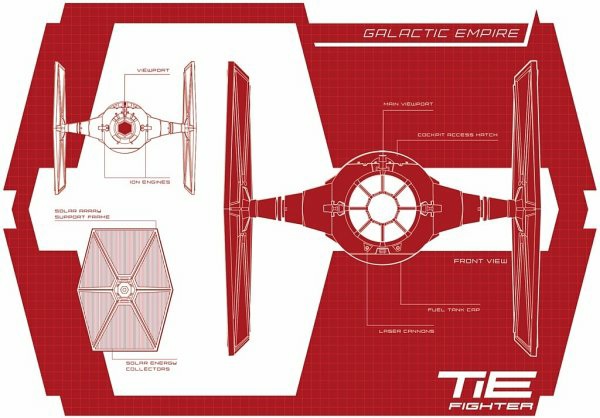
Technical drawing of a TIE/ln starfighter
The TIE/ln starfighter was a small, short-range fighter developed, manufactured, and mass produced by Sienar Fleet Systems (SFS). Developed by SFS company head Raith Sienar, the basis for the TIE fighter can be traced back to Kuat Systems Engineering's Alpha-3 Nimbus starfighter, along with several other outmoded models from the Old Republic. Like their predecessors, TIE's employed two vertical wings similar in appearance to V-wing starfighters; however, the Eta-2 Actis-class light interceptor bore even more similarities with its central cockpit pod, twin ion engines, and common weapons technology.
The fighter's name is derived from its propulsion system, which was specifically designed to create a distinct noise so as to inspire fear in those who opposed the Empire. These were originally two P-s3 ion engines, which would be replaced by twin P-s4 ion engines by approximately 14 BBY. These engines could expel charged particles along almost any vector, providing the TIE fighter with incredible maneuverability, and their lack of moving parts or high-temperature components made them easier to maintain: Imperial records indicated less than five percent of all TIE fighters lost were as a result of field attrition. Fuel for the engines consisted of a radioactive gas kept in pressurized fuel tankage located on the underside of the cockpit.

A Rebel T-65B X-wing starfighter in the sights of a TIE fighter's targeting computer
A TIE fighter's twin ion engines, combined with W-401 maneuvering jets, provided thrust and boosters capable of quickly adjusting the ship's direction. The TIE/ln featured vertical takeoff and landing (VTOL) capabilities owing to repulsorlift cyclers in its wing struts—reducing its already small mass to negligible weight—and micropositioning thrusts from the twin ion engines. Furthermore, the lack of a hyperdrive and resultant navigational systems alongside extended life support and fuel combined to cut down the TIE's total mass.
In order to reduce cost, mass and energy consumption while improving maneuverability, the TIE fighter lacked deflector shields. It was armored with quadanium steel plating which was proof against hand-held blasters (except in exposed areas such as the stabilizers) but could be penetrated by direct hits from military-grade laser cannons, heavy blaster cannons, and micrometeor impacts. However the cockpit's spherical shape meant that glancing blows would be deflected away. TIE fighters were equipped with sensor jamming capabilities and could be retrofitted with additional electronic countermeasures.
The fighter's black "wings" were in fact an array of twelve solar collectors, framed by rigid quadanium steel foil braces, that featured a micro-crenulated solar absorption surface. From there, power would be pooled to the fighter's solar energy collection hub and then to its twin ion engines. Originally the wings also powered the fighter's armaments, but this was found to quickly drain the fighter of energy and negatively affected its maneuverability. These early fighters were later retrofitted with a dedicated generator to power the lasers, a feature that became standard on all TIE fighters. These wings also served as stabilizers.
The wings were sturdy enough to double as landing gear, further reducing overall mass, however, TIE fighters were designed to be deployed and retrieved using special cycling racks. Standard on Star Destroyers and other Imperial facilities, each rack system had a maximum capacity of 72 fighters. Beyond allowing pilots and technicians to access the craft more easily, the system was also equipped with small tractor beam projectors to assist with landing operations.
One drawback to the wing design was that it did obscure the pilot's field of vision, yet Imperial authorities considered this an acceptable motivation for pilots to concentrate on the targets in front of them. Due to its importance as a stabilizer, if part of the wing were to be removed to increase sight it would cost the fighter stability, which would then hamper the ship's ability to engage in dog fights. The wings did provide some measure of additional protection for the cockpit, and the fighter's sensor array compensated for the blind spots by augmenting and expanding the pilot's visual range.
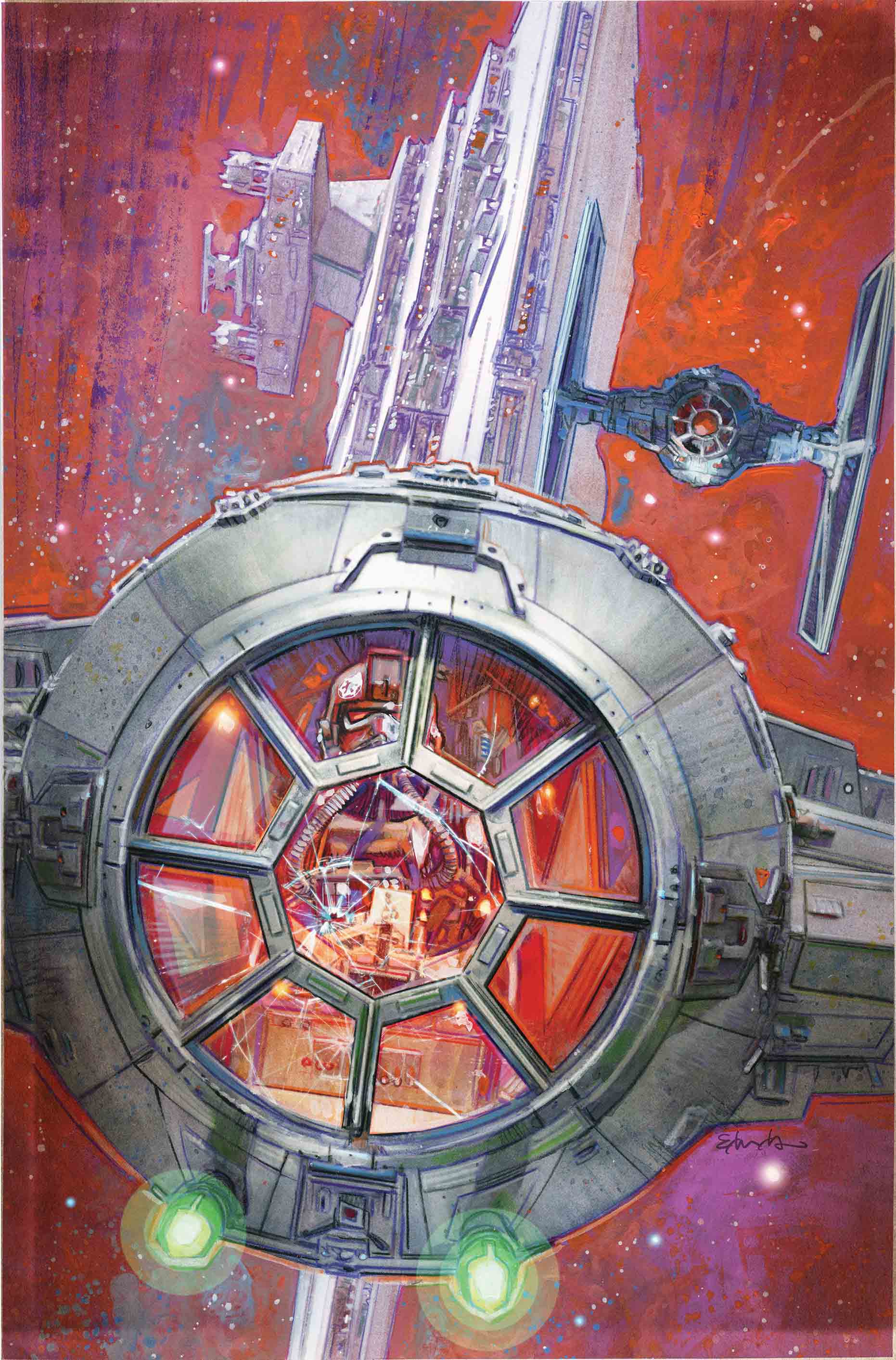
Imperial TIE fighters
The TIE/ln was first and foremost designed for space combat, and while capable of operating in a planetary atmosphere it was at a distinct disadvantage versus other starfighters like the X-wing. The hexagonal wings made it harder to steer and more vulnerable to crosswinds. If it attempted to reverse its thrust too hard in order to decelerate, the fighter also risked causing severe structural damage to the wing spars and support pylons. However, depending on the circumstances the TIE fighter could still give a good account for itself in atmospheric combat. When operating down in tight urban confines and an oxygen-rich atmosphere for example, a TIE fighter was equal to an X-wing in speed and maneuverability. At higher altitudes it could also successfully engage in dogfights with X-wings at supersonic speeds.
The TIE fighter's primary armament was a pair of L-s1 low-temperature laser cannons capable of destroying a Taylander shuttle in a single shot, although by the time of the Battle of Endor these had been replaced with L-s7.2 laser cannons. The green blaster bolt these weapons fired was the result of the more expensive blaster gas used by the Empire and aided pilots in identifying their shots. Mated to the cannons was an advanced T-s8 targeting computer—later replaced by the T-s9a model—which was considered superior to the targeting computers on Rebel fighters. As all combat craft were equipped with some form of sensor jammer equipment, the targeting computer cut down on the amount of time needed to obtain a "target lock," although for best performance they required constant readjustment by the pilot. While TIE fighters lacked any secondary weaponry as standard, they could be retrofitted to carry additional armaments such as missiles or replace their normal laser cannons with other models or ion cannons.
Its central cockpit was tightly fitted, incorporating flight controls, viewscreens, targeting systems, tracking equipment—including a homing beacon in case the vessel was stolen—and room for a pilot all in the central pod. Despite being designed for a single occupant, several other passengers could fit inside the central cockpit, although the fit would be extremely tight. A pressurized seal allowed the cockpit to retain an atmosphere and minimal, perfunctory oxygen scrubbers to protect the equipment, but the lack of any life support system required pilots to wear special flight suits and vacum-sealed flight helmets. The onboard data recorder, kept within an armored compartment beneath the pilot's seat, was designed to survive any event which would otherwise reduce the TIE fighter to scattered debris to allow for later retrieval and analysis.
Flight controls were considered intuitive and easy to learn, in some cases allowing rebel novices to fly and operate them after having stolen them from Imperial airfields. TIEs were also outfitted with an ejector seat. Equipped with an antigrav unit and automated safety system, the seat was designed to guide the pilot away from debris and prevent any serious injury such as spinal fractures by determining when to release restrains or deploy the parachute. It was also equipped with a locator beacon to aid in pilot recovery.
During the reign of the Empire, TIE fighters were favored for their versatility, if not for their durability. They were able to operate both in space as well as in planetary atmospheres, acting as fighters or scouts. They were more than capable of enforcing Imperial law against unarmed or lightly defended civilian transports. TIE/ln pilots were not afforded the independence enjoyed by equivalent pilots of the Rebel Alliance, as capital ships were preferred for tactical discussion among the Imperial Starfleet. In Imperial doctrine, individual TIE fighters were used for scouting while a pair of fighters would be used to escort shuttles and other craft. A group of four TIE fighters, called a sentry group, was deployed to patrol the area around an Imperial ship or facility. A typical attack squadron consisted to 12 TIE fighters, and six squadrons together made up a full attack wing of 72 fighters.
At least a month after the Battle of Jakku, all TIE/ln starfighters were upgraded with advanced weaponry invented by Ved Foslo, allowing them to punch through an enemy fighter's shields as well as hull, destroying them in a single hit.
Following the transformation of the Galactic Republic into the authoritarian Galactic Empire, Republic era weapons and equipment would continue to be utilized throughout the Imperial sphere. As time went by, the Republic's Eta-2 Actis-class light interceptor and ARC-170 starfighters began to be phased out roughly five years after the proclamation of the New Order. The Empire's regional Governor of the Outer Rim Territories, Grand Moff Wilhuff Tarkin, commissioned Sienar Fleet Systems to create a line of single-pilot, short-range starfighters for the Imperial Navy. Tarkin mandated that the weaponized fighters should be extremely fast and manuvarable, energy efficient, and inexpensive to manufacture.
Building off the advancements in starfighter engineering seen during the Clone Wars, Raith Sienar personally designed the fighters, basing them off designs from the Star Courier, Alpha-3 Nimbus-class V-wing starfighter, and the Eta-2 Actis-class light interceptor. The result was a central spherical pod positioned between two hexogonal solar energy-collecting wings. To minimize power drain and maximize manuverability, Sienar eschewed typically standard systems such as deflector shields and a hyperdrive. After a series of test flights, the Empire approved Sienar's design, and executed an exclusive contract with Sienar for the production of TIE fighters. TIE fighters began to roll off assembly lines, with the Imperial mechanic Willard Waylin working on the TIE line since the beginning of their deployment.
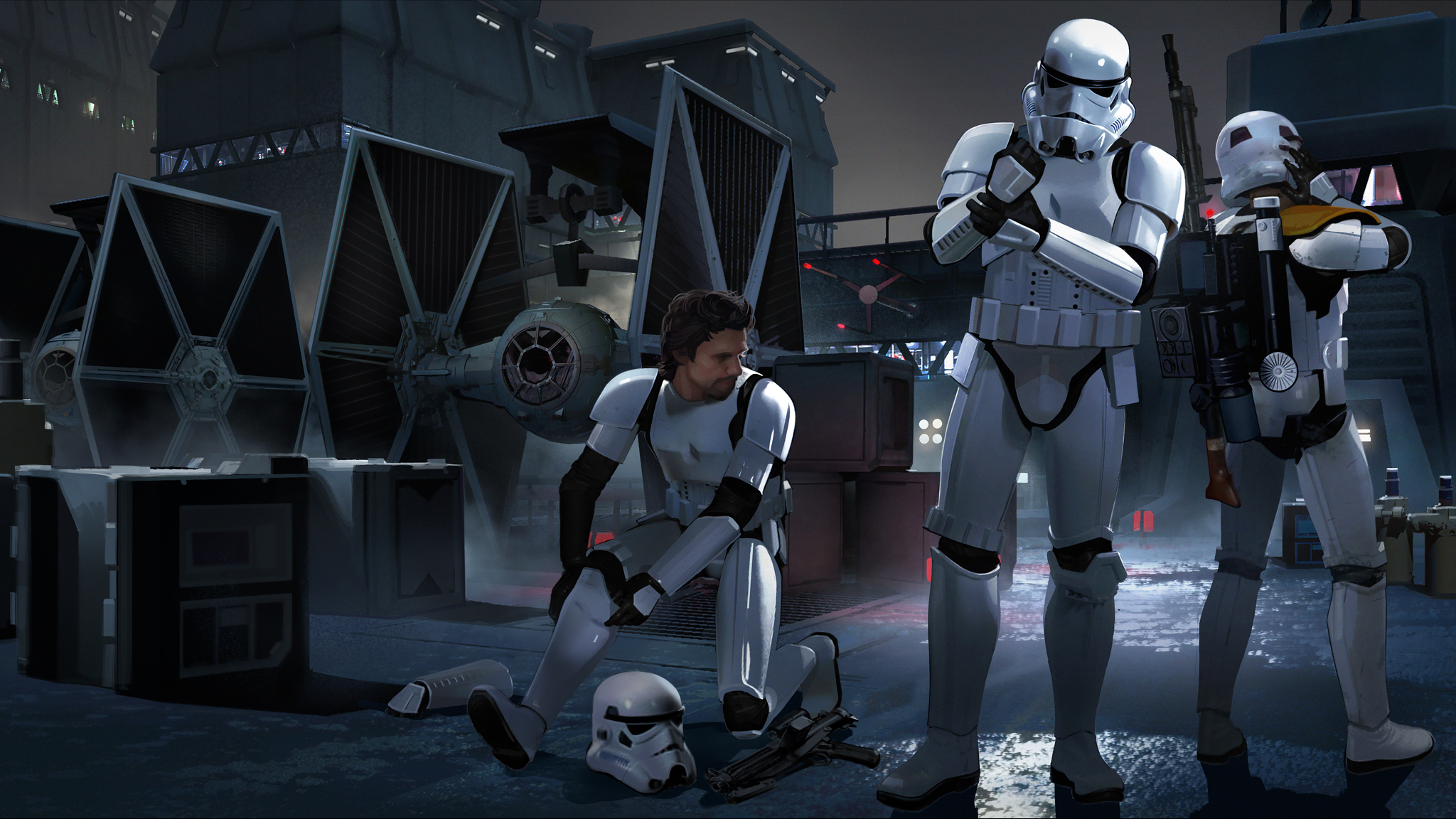
TIE fighters stationed at an Imperial airfield
With TIE pilots instructed to ignore their own well-being in order to achieve their objectives, the fighters were extremely fragile and their pilots expendable. With the Imperial Navy's vast size and unchallenged reign over the galaxy, the use of swarm tactics and subsequent mass production and refreshment of the vessels barely put a dent into Imperial manpower and industrial capacity. The low cost of production also spurred the craft's use. As a result, many features were sacrificed to facilitate mass production by Sienar Fleet Systems factories. Wilhuff Tarkin, an excellent pilot in his own right, was known to think very poorly of the TIE fighter due to its cramped cockpit and seemingly disposable nature. Imperial fighters also acted as psychological deterrents to potential seditious activities, with their roaring engines inspiring fear in those who heard them, leading to Imperial commanders to order their pilots to purposely fly low over areas that needed reminding of Imperial might.
Waylin would meet TIE pilots over his career as he worked on the ships and was always impressed by their refusal to back down, figuring that the ship design's drawbacks built character. As part of the five-year plan for the industrialization of the Outer Rim Territories, TIE fighters were produced on a number of planets, including Lothal. The Empire also gave some of its TIE fighters to loyalist companies to help secure its interests, leading to variants such as the Mining Guild TIE fighter.
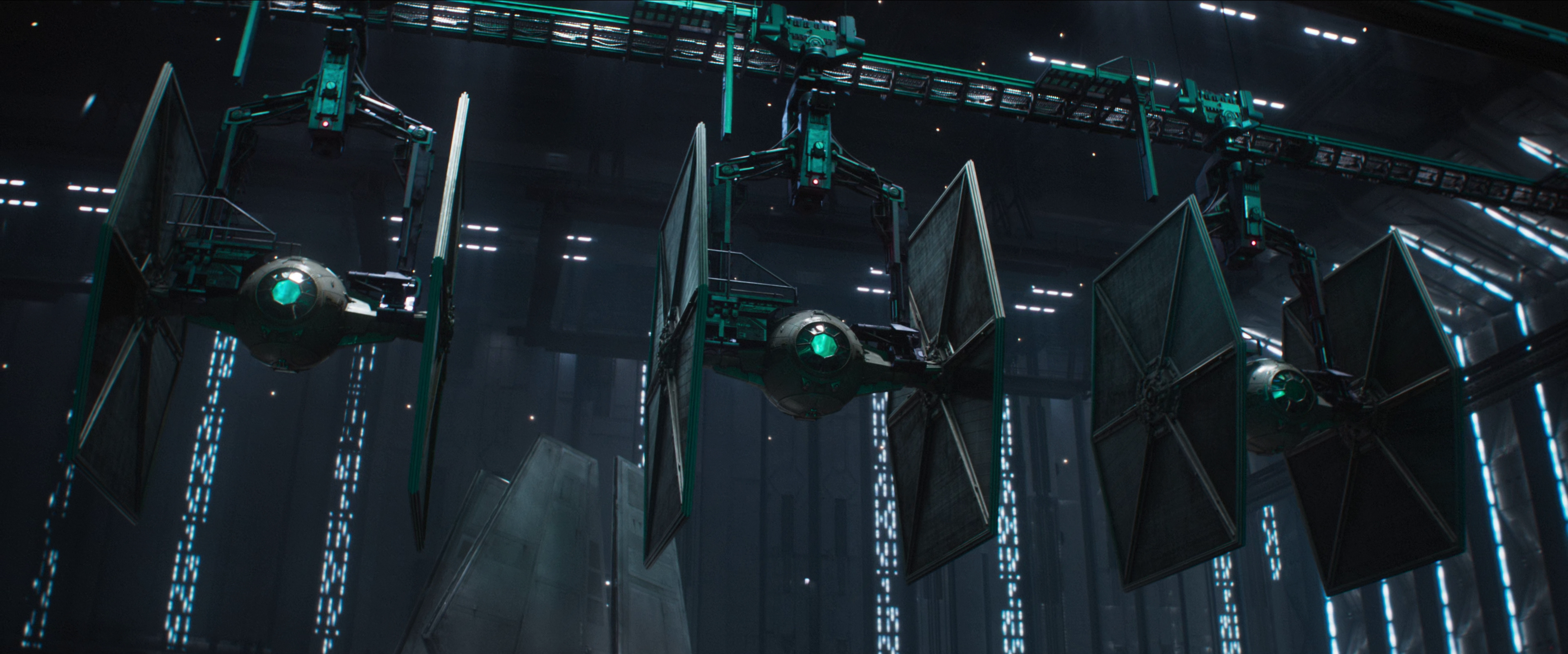
TIE fighters at the Aldhani Garrison
While the Empire's rule was absolute for years, rebels had begun to arise as early as a year into its reign and an early rebellion against the Galactic Empire was waged. The Spectres fought Imperial forces, including TIE fighters, on Lothal and later joined with the Phoenix Cell. In 2 BBY, Mon Mothma brought various rebel cells together as the Alliance to Restore the Republic. While TIE fighters could engage unarmed and slightly defended civilian transports, they faced a more formidable foe in the form of the Alliance's starfighters.
Following the destruction of the first Death Star, the classification between Army and Navy pilots—referred to as ground-hogs and vac-heads respectively—was rescinded, and the Imperial Military was to undergo a mass reorganization.
After the Rebels hijacked the Imperial I-class Star Destroyer Harbinger, Luke Skywalker and Sana Starros use the stolen TIE fighters to patrol.
Over time, a variety of other models arose from the TIE line, including notable vessels such as the TIE/IN interceptor, TIE/sa bomber, TIE/sk x1 experimental air superiority fighter, TIE/d "Defender" Multi-Role Starfighter, and the TIE/rp Reaper attack lander, partly in direct response to faster and newer vessels manufactured by the Rebel Alliance. A variety of sub-models of the TIE fighter series had arisen throughout Imperial history, with Sienar factories experimenting with localized improvements, producing advanced models suited to flying in local conditions and incorporating secret technological breakthroughs. Ships such as the TIE Advanced v1 fighter would see use by flight barons and high-ranking members of the Inquisitorius, however its extreme cost would later relegate its successor, the TIE Advanced x1, to be flown only by elite pilots and members of the Imperial hierarchy such as Lord Vader. By the time of the Battle of Endor, TIE/IN Interceptors made up 20% of the Empire's starfighter fleet.
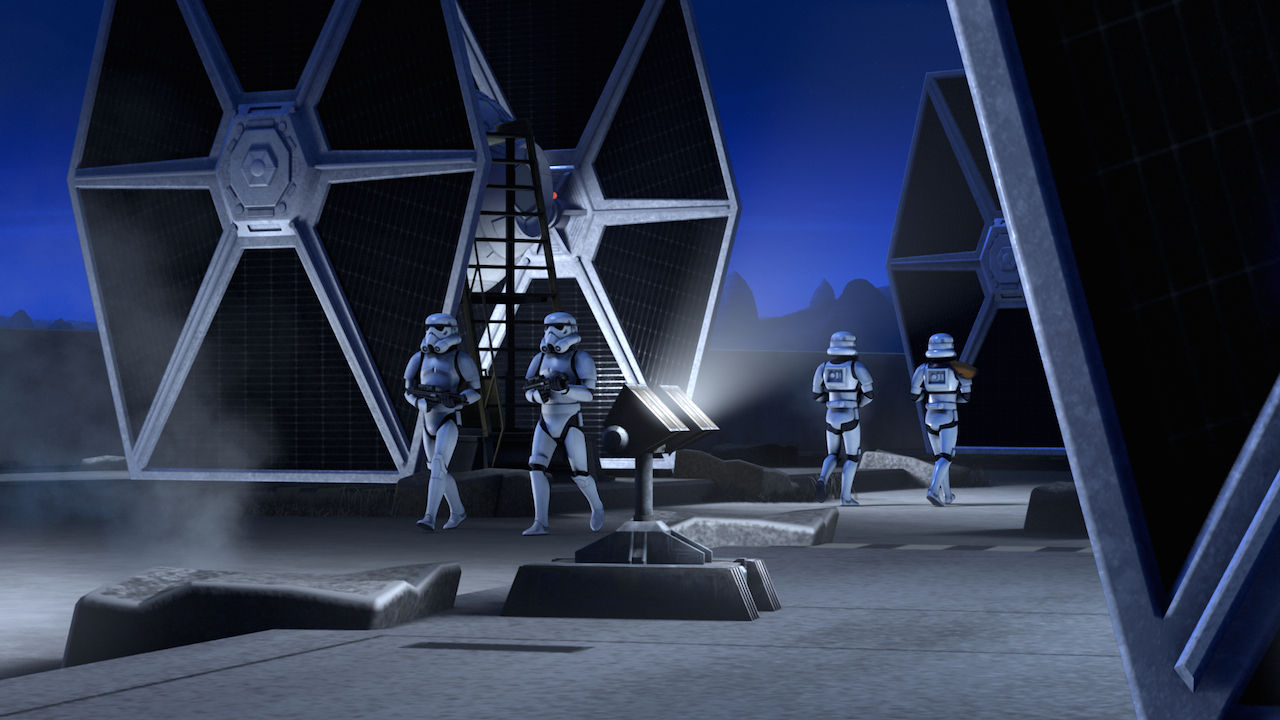
TIE fighters on a Lothal airfield
Following the Battle of Endor, Imperial supply shortages would hinder the production and further development of TIE/ln starfighters, forcing Imperial-class Star Destroyers to make do with an inadequate number of ships and inexperienced pilots.
Production data was classified, but according to numerous estimates, Sienar manufactured a minimum of approximately 4.6 million Imperial TIE fighters for Star Destroyers, other Imperial Naval vessels, and Imperial garrisons and defense stations. Most estimates maintain that more Imperial TIE fighters were operational at the same time than any other starfighter in history.
The legacy of the TIE fighter was not forgotten on the galactic stage, with Sienar Fleet System's successor, Sienar-Jaemus Fleet Systems, producing the latest-generation TIE fighters utilized by the Empire's successor state, the First Order. The TIE/sf space superiority fighter and TIE/fo space superiority fighter were a direct continuance of the imprint the TIE fighter had on galactic citizenry, and featured advanced weapons systems and a two-seated arrangement for use by the Order's Special Forces.
The Ugnaught Kuiil, himself former indentured servant of the Empire, used a workbench built out of an abandoned TIE cockpit. Future historians would argue that flaws inherent in the TIE fighter design were allowed to remain, if only to increase the Empire's dependency on Sienar Fleet Systems for continued production of the craft, along with increased dependency on Kuat Drive Yards capital-scale carrier ships.
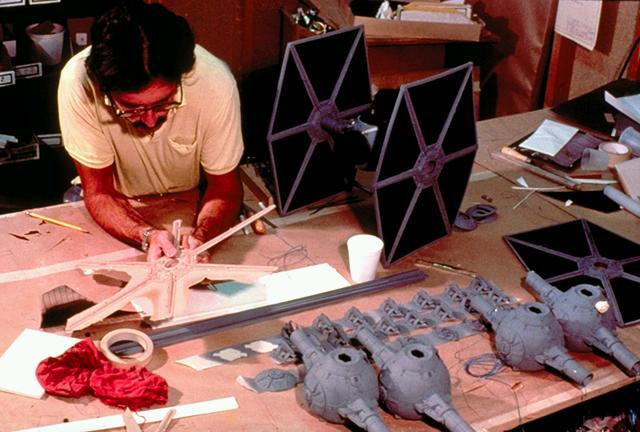
TIE fighter models being constructed for A New Hope
Industrial Light & Magic's (ILM) Colin Cantwell created the concept model that established the TIE fighter's ball-cockpit and hexagonal-panels design for A New Hope. Sound designer Ben Burtt created the distinctive TIE fighter sound effect by combining an elephant call with a car driving on wet pavement.
The original TIE/ln fighters seen in A New Hope were relatively white, but were originally meant to have a maroon hull. One of the benefits of a slightly reddish color would have been that the fighter models would not have been as prone to "blue spill" as gray models were during filming against a blue screen. However, film composition tests revealed that the maroon ships blended too quickly into the mostly black star field when moving away from the camera, so a light gray was used instead. The TIE fighter models featured in The Empire Strikes Back and Return of the Jedi were blue-gray.
Combat scenes between TIE fighters and the Millennium Falcon and Rebel Alliance X-wing fighters in A New Hope were meant to be reminiscent of World War II dogfight footage; editors used World War II air combat clips as placeholders while Industrial Light & Magic completed the movie's special effects.
TIE/ln fighters are one of two starships available to Imperial players in Star Wars Battlefront, the other being the TIE/IN interceptor. Compared to the X-wings and A-wings, TIE fighters lack shields but instead possess good maneuverability and speed. However, their large wing panels make them very easy to hit in dogfights, giving Rebel fighters a slight advantage in ship-to-ship engagements.
Ultimate Star Wars stated that TIE fighters built on Lothal had shorter wings, as explanation for stylistic choices made for the TIE/ln's design in the animated series Star Wars Rebels. However, said that there is no difference. Since then, Pablo Hidalgo confirmed on Twitter that Ultimate Star Wars was incorrect.
The reference book Star Wars: Rogue One: The Ultimate Visual Guide was the first reference book to identify the TIE fighter as the TIE/ln space superiority starfighter. It also defined the "ln" within the starfighter's name as standing for "line edition."
- Rogue One: Recon A Star Wars 360 Experience
- LEGO Star Wars: A New Hope
- LEGO Star Wars: The Freemaker Adventures — "A Hero Discovered"
- LEGO Star Wars: The Freemaker Adventures — "Zander's Joyride"
- LEGO Star Wars: The Freemaker Adventures — "Peril on Kashyyyk"
- LEGO Star Wars: The Freemaker Adventures — "Crossing Paths"
- LEGO Star Wars: The Freemaker Adventures — "The Maker of Zoh"
- LEGO Star Wars: The Freemaker Adventures — "Return of the Kyber Saber"
- LEGO Star Wars: The Freemaker Adventures — "Rowan's Secret Adventure"
- LEGO Star Wars: The Freemaker Adventures — "Thrown Into Battle"
- LEGO Star Wars: The Freemaker Adventures — "Zander Freemaker, Superstar Pilot Guy!"
- LEGO Star Wars: The Freemaker Adventures — "Trouble on Tibalt"
- LEGO Star Wars: The Freemaker Adventures — "The Storms of Taul"
- LEGO Star Wars: The Freemaker Adventures — "The Lost Crystals of Qalydon"
- LEGO Star Wars: The Freemaker Adventures — "Flight of the Arrowhead"
- LEGO Star Wars: The Freemaker Adventures — "A Perilous Rescue"
- LEGO Star Wars: The Freemaker Adventures — "Escape from Coruscant"
- LEGO Star Wars: The Freemaker Adventures — "Free Fall"
- LEGO Star Wars: The Freemaker Adventures — "Return of the Return of the Jedi"
- LEGO STAR WARS: Celebrate the Season — "Twas the Night Before Life Day"
- LEGO STAR WARS: Celebrate the Season — "Droid Holiday Hustle"
- Disney Infinity 3.0
- LEGO Star Wars: All-Stars — "The Chase with Han/Escape with Chewbacca"
- Star Wars Resistance Racer
- LEGO Star Wars: All-Stars — "Dealing with Lando/Han and Chewie Strike Back"
- The LEGO Star Wars Holiday Special
- LEGO Star Wars: The Skywalker Saga
- LEGO Star Wars Terrifying Tales
- Star Wars: Visions — "THE TWINS"
- Star Wars: Visions — "T0-B1"
- LEGO Star Wars Visual Dictionary Updated Edition
- The Art of Star Wars: Visions